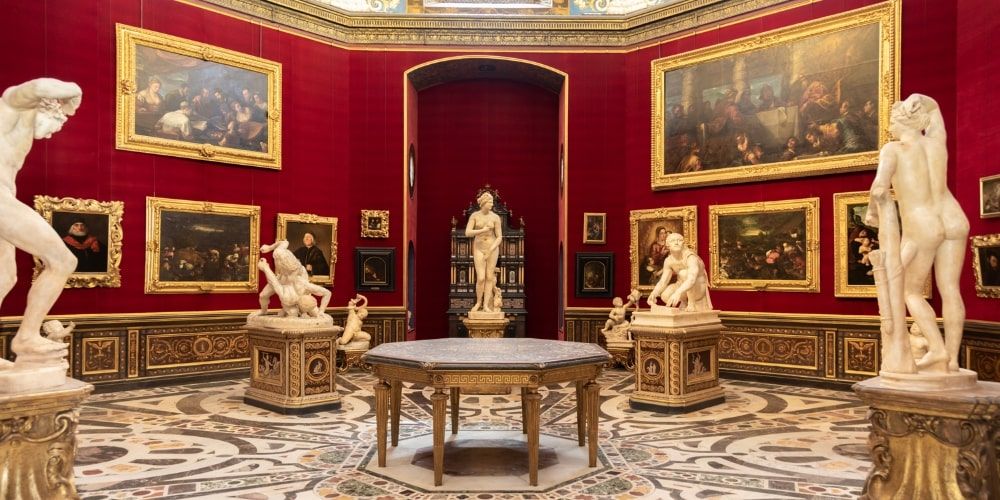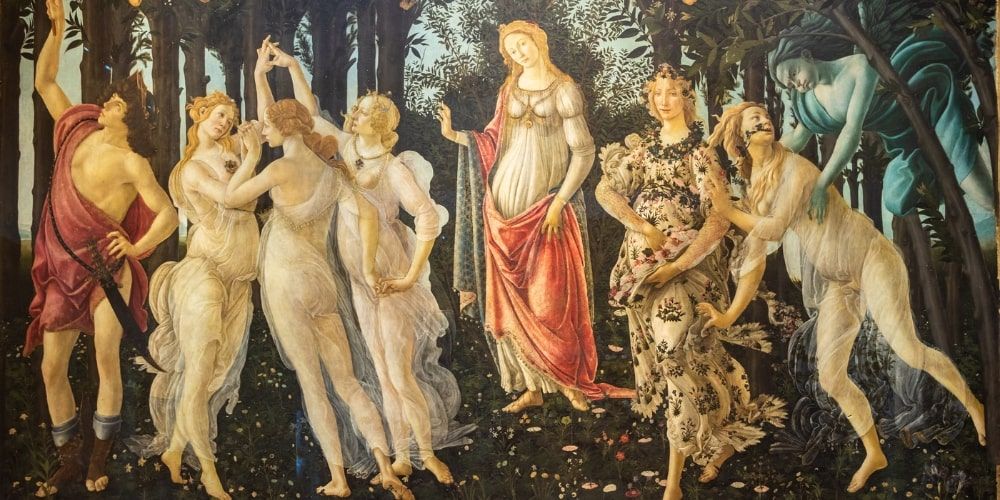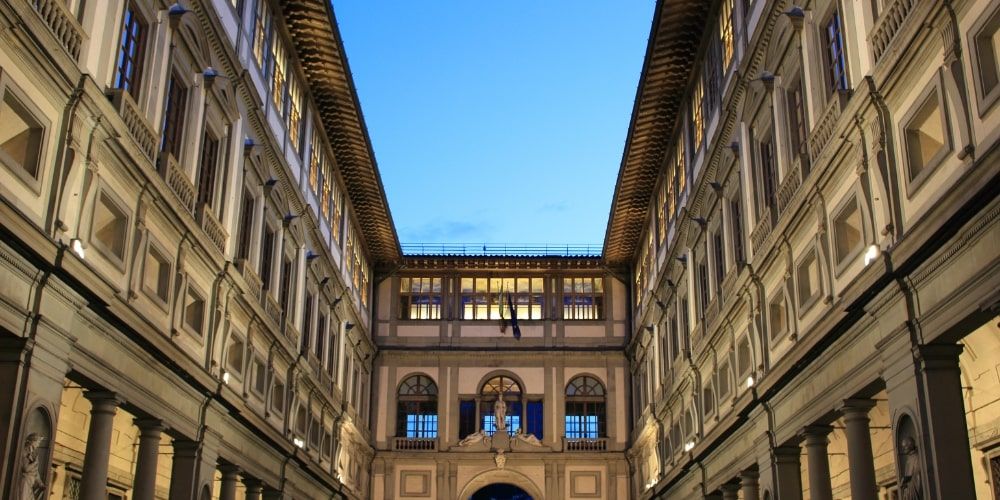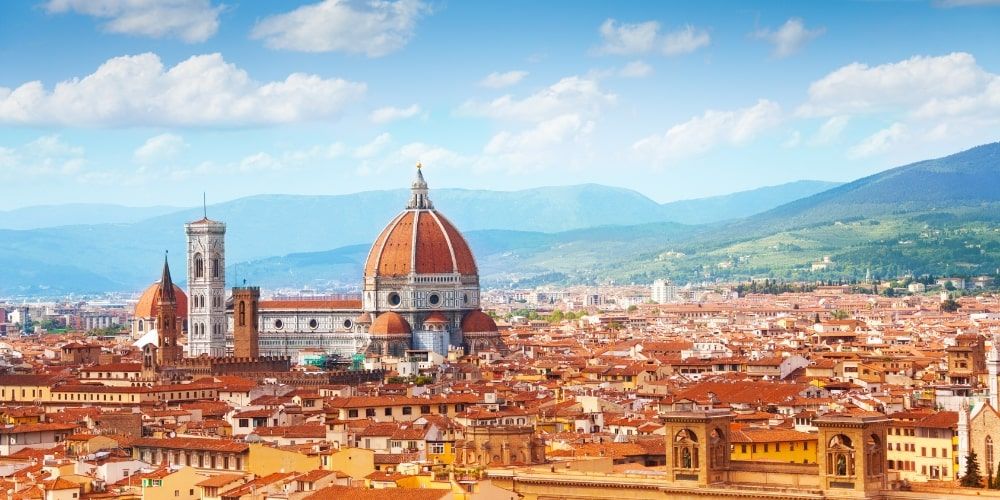Are you wondering how to visit the Uffizi Gallery with little time to spare? The famous Gallery is a treasure trove of priceless masterpieces, appreciated and visited by millions of travellers yearly. It is the sublime symbol of artistic research committed to achieving aesthetic perfection and the enthusiastic creative flair of the human being. Visiting the Uffizi Gallery will allow you to appreciate the magnificent halls of this prestigious museum. Let's take a fascinating journey through time among the beautiful paintings and magnificent sculptural works by famous artists active over half a millennium, from the medieval period to the contemporaneity age.
The building that houses this astonishing collection was commissioned by Cosimo I de Medici, who entrusted the illustrious architect and artist Giorgio Vasari with the task of drawing up a project to give a new sheen to an ancient Florentine quarter, built between 1560 and 1580. Formerly it was intended to be the location for the offices of the municipal administration, magistrates of the city of Florence, and the State Archives. Traces of the ancient quarter remain in the Church in the archaeological finds incorporated in the current architectural configuration of the museum.
If you are dreaming of visiting the Uffizi Gallery during a possible trip through the fascinating Tuscan territories, follow Visit Italy's advice to make the most of all the available opportunities, living a unique experience in contact with history and the Italian cultural heritage. By choosing the most suitable options to visit the Uffizi Gallery, you will avoid the crowds of tourists on hold. Let's embark on this magnificent tour to discover the gems of the Uffizi Gallery. The triumph of artistic wonders created during the heyday of the Renaissance courts will enchant you so much that you'll want to explore the other iconic sites in this delightful city.

How to visit the Uffizi Gallery: the masterpieces of Italian Renaissance

Reaching this temple of culture, you will be mesmerized by the majesty of the architectural complex and the admirable statues placed under the Gothic arches of the Loggia dei Lanzi. The classical Doric style refers to the values on which the Prince's governmental activities were located. Contemplating the elegant façade, one can distinguish three compositional levels, the portico, the loggia, and the piano nobile. Before starting to visit the Uffizi Gallery, what strikes the visitor is the kaleidoscopic effect created by the alternating shades of pietra serena, which stand out against the white plaster. The exhibition section extends into the charming rooms on the first and second floors.
The floor plan of the building follows a U-shaped structure, whose interiors were admirably embellished and decorated over the centuries by the refined pictorial mastery of talented artists, such as Bizzelli, Allori, and Pieroni, who executed stupendous grotesque paintings. In 1565 the primordial structure was enlarged with the addition of the Vasarian Corridor, making it possible to move from Palazzo Vecchio to Palazzo Pitti, guaranteeing security and privacy for the members of the Medici noble family.
Visiting the Uffizi Gallery takes time and, by reading our guide, you will learn how to optimise. your trip. Following the exhibition route, you can visit the Uffizi Gallery and admire the splendid paintings of the Carracci family, Guido Reni, and Artemisia Gentileschi. The cornerstone of the Uffizi Gallery is the tribune, a magnificent octagonal room embellished by the genius of Buontalenti in 1581. Its representational model was the ancient Torre dei Venti, mentioned by Vitruvius in his treatise De Architectura. Anna Maria Luisa de Medici decreed that the precious masterpieces in the museum exhibition should stay in Florence forever. Furthermore, in 1769, Pietro Leopoldo of Lorraine made the vast collection of paintings and sculptures available to the general public.
As you begin your tour of this beauty-packed location, you will discover that the interior area consists of three sections, called the east, noon, and west hallways. In the decade between the 1670s and 1680s, Francis I began to embellish the loggia above the courtyard with beautiful paintings and sculptural works. Looking out of the lovely stained-glass windows that intersperse the corridors, you will admire the main monuments of this enchanting city, such as the striking Ponte Vecchio, Orsanmichele, Santa Maria del Fiore, Palazzo Vecchio, and the surrounding hills. As you walk through the corridors, the grandeur of the frescoes with mythological and allegorical themes extolling the Medici splendor will allure you.
We have a surprise in store for you who are reading articles of VisitItaly: you can buy our tickets to benefit from primary admission to the Uffizi Gallery! Do you want to find out more? Click on the button.
Last Minute Visit to Uffizi GalleryHow to visit the Uffizi Gallery: tickets and guided tours

You have numerous options to choose from to visit the Uffizi Gallery. Booking tickets online is the best way to save yourself long hours of waiting. As only 900 people are allowed in at a time, we suggest you choose the most convenient times of the day in advance. You will manage to enter through Door 3, avoiding the queue. The Gallery's timetable provides for visitors to enter from 8.15 am. Reservations allow for 25 visitors per time slot. If you prefer to be assisted during your visit, you can take advantage of a guided tour, providing additional information to enrich your knowledge. You can also book a guided tour in advance and benefit from a reserved entrance to the exhibition rooms. You will have a professional multilingual guide at your disposal, and you can also take advantage of a free audio guide. We recommend November to March as the best months to visit the Uffizi Gallery. If you prefer to admire the works of art at a leisurely pace, the best times are late afternoon on Wednesdays and Thursdays.
Access is free for teachers and students of the Fine Arts Academies and the faculties of Architecture, Education, Conservation of Cultural Heritage, Humanities, and Philosophy who are regularly enrolled and for researchers with specific professional and study requirements.
For more information on how to visit the Uffizi you can consult the official website. If you want to visit the Uffizi and have limited time, however, you can take advantage of priority access, or buy a last-minute entry. Find out how here.
Discover Uffizi last minute with AudioguideHow to visit the Uffizi Gallery: artworks you can admire

The exhibition itinerary revolves around four thematic routes, painting, sculpture, architecture, prints, and drawings. Following the guided itinerary that encompasses the two floors, you will have the opportunity to visit the Uffizi Gallery and enjoy the splendor of the works divided according to chronological criteria. In case you are short of time to visit the Uffizi Gallery, we indicate the main rooms housing the most important works of art to optimize your visit to the Uffizi. Room 2 displays Giotto's Madonna di Ognissanti, an altarpiece that recovers three-dimensionality, distancing itself from Byzantine art, and the Majesties by Duccio di Buoninsegna and Cimabue. In rooms 5 and 6, one can enjoy the paintings of Cortese Gothic, such as Gentile da Fabriano's Adoration of the Magi.
The Botticelli Room, which exhibits the most relevant paintings of the famous Renaissance painter, extends from section 10 to section 14: in this area, you will find the Birth of Venus, Primavera, which represents the watershed between materiality and spiritual values, Portrait of a Man with Medal by Cosimo the Elder, Madonna of the Magnificat, Coronation of the Virgin and Madonna of the Pomegranate. Section 15 houses Leonardo da Vinci's earliest paintings, including the Annunciation, the Baptism of Christ, and the Adoration of the Magi, painted using the oil-on-table technique with a base of tempera grassa. The corridor overlooking the beautiful cityscape lapped by the Arno River features religiously inspired frescoes, the statues of Cupid and Psyche, the Seated Venus sculpted by Phidias, the Olympia, the Seated Maiden Ready to Dance, and the Dancing Satyr. The area between rooms 25 and 34 focuses on 16th-century art. Here we find Michelangelo's Tondo Doni, a pillar of Mannerist art, Parmigianino's Madonna with the Long Neck, and the Venus of Urbino by the talented Titian.
The exhibition area dedicated to the 15th century follows regional classification, and it hosts works by artists from Veneto, Emilia, Florence, and Lombardy. Between 2010 and 2012, the itinerary was increased with paintings by 17th and 18th-century artists, such as Goya, Velazquez, Ribera, Vouet, Le Brun, and Rembrandt. In the nine red rooms, we can admire the paintings of the Florentine Mannerists, treasures of ancient art by Bronzino, Andrea del Sarto, Pontormo and Rosso Fiorentino, Raphael, and Caravaggio, including the head of Medusa and the adolescent Bacchus: in this section, you can appreciate Raphael's Madonna of the Goldfinch. Other paintings that we suggest you contemplate are Saint Anne and the Madonna and Child by Masolino and Masaccio, the Battle of San Romano by Paolo Uccello, dating back to 1438, the paintings of Federico da Montefeltro and Battista Sforza by Piero della Francesca and the Madonna and Child with Two Angels by Filippo Lippi.
How to arrive at the Uffizi Gallery

Would you like to how you can get to the historic centre of Florence to visit the Uffizi Gallery? The famous museum is easy to reach on foot since it rises in the heart of the historical center, near the legendary Ponte Vecchio and the picturesque Piazza della Signoria. If you are near the Santa Maria Novella station, the journey time will be about 15 to 20 minutes. The main path to arrive and visit the Uffizi Gallery goes through Via Cerretani, Piazza del Duomo, Via Calzaiuoli, Piazza della Signoria, and the Loggia dei Lanzi. If you are arriving from an area outside the city, many public car parks are available. You can find them around the perimeter of the historic center, including in Piazza del Duomo and Pizza Mentana. If you prefer choosing public transport, the most convenient alternative to visit the Uffizi Gallery is the C1 bus line, whose stop is distant just a few meters from the gallery.
How to visit the Uffizi Gallery: what do you have to know to enjoy the trip to the exhibition

• How to visit the Uffizi Gallery: the masterpieces of the Italian Renaissance
• How to visit the Uffizi Gallery: tickets and guided tours
• How to visit the Uffizi Gallery: artworks you can admire
• How to arrive at the Uffizi Gallery
• How to visit the Uffizi Gallery: what do you have to know to enjoy the trip to the exhibition
About the author
Written on 27/02/2023




Simone Pini
Are you an art enthusiast and do you want to know how to visit the Uffizi Gallery in three hours? Find out marvelous masterpieces with Visit Italy.